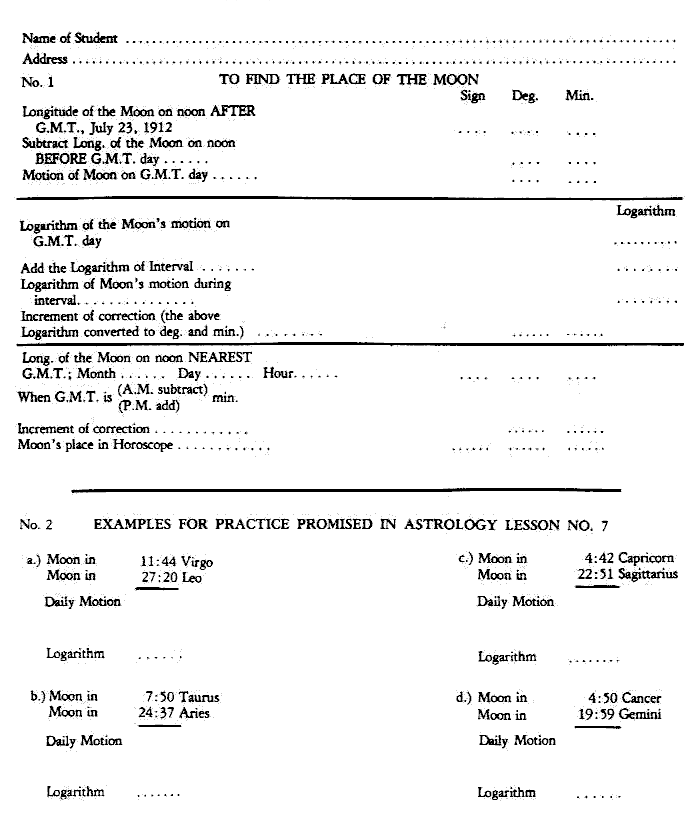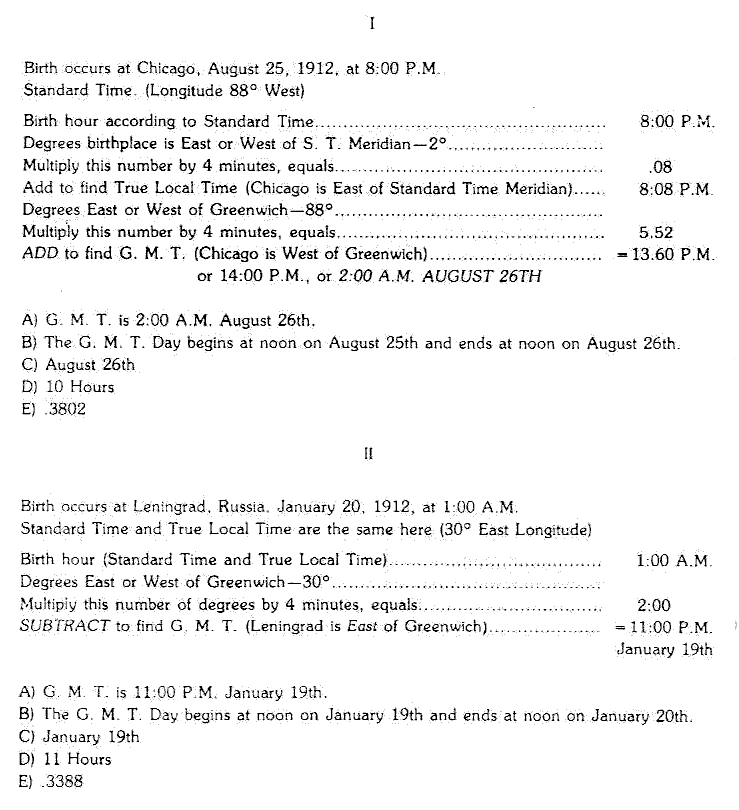Astrology Self-Study
Module No. 7
Dear Friend,
The dynamic energy of Mars, which is the power that moves the world from the civil and industrial standpoints, under certain afflictions becomes recklessness and destructiveness, making the person so expressing it a dangerous man, a public enemy. When the Venus ray is afflicted, it curtails the sense of beauty and order; hence the person becomes slothful, disorderly, and lacking in proper self-respect. Incapable, because of the affliction, of feeling true love, such a person becomes perverted and licentious, and it is often said of him: "He is his own worst enemy." Such people do not harm others intentionally; yet they spread an immense amount of unhappiness among those whom they profess to love. One of these classes is dangerous to society because it has not the love ray of Venus to guide its exuberant energy; the other, because it lacks the dynamic energy necessary to carry its good intentions into execution.
We see these classes in the world, and the misery they cause themselves and others; but usually their character has become "set," and we can do but little to change their condition and must leave them to the schoolmaster "Experience." Children are growing up among us and our chances of helping them are great.
When the "Spirit" spoke to the churches in Revelation, it found fault in many directions; but one received a stinging rebuke: "I wish thou wert hot or cold, but because thou art neither I will spew thee out of my mouth." The so-called "bad boy" is not nearly so difficult a problem as one who is so goody-goody that he is likely to turn out to be a good-for-nothing, a pitiable human wreck. You will do well to look the latter over constantly and thoroughly, and remind him of the slightest neglect or mistake. It takes strength to be a sinner, and the worst boy becomes the best man when Mars has been downed by Venus; but the greatest firmness is required to correct an afflicted Venus and give the child sufficiently dynamic energy to be really, instead of seemingly, good.
Astrology
Independent Study
Module No. 7
Chart Construction
Part VII
In the horoscope we are calculating the Greenwich Mean Time is July 23, 1912, 10:56 A.M.. The interval between that time and the nearest noon is 1 hour and 4 minutes; the logarithm of that interval is 1.3522; the G.M.T. day commences on the noon of July 22, and ends on the noon of July 23rd. With these results of previous calculations in mind we turn to page 16 of our ephemeris for 1912; here the longitude of each planet is tabulated below the heavy black line.
The column next to the figures indicating the days of month, gives the Sun's longitude for noon at Greenwich, and in order to ascertain its position at the Greenwich Mean Time of birth, July 23, 1912, 10:56 A.M., we must find the Sun's motion on the G.M.T. day, from noon July 22 to noon July 23.
The rule is as follows:
Rule I
From the longitude of a planet on the noon after the G.M.T. of birth subtract its position on the preceding noon; the difference is the motion of the planet on the G.M.T. day.
Our Greenwich Mean Time of birth is July 23, 10:56 A.M., and the noon after that time is obviously the noon of July 23. On page 16 of our ephemeris we find:
| Sun's Longitude, July 23: |
Leo |
00 |
13 |
| Subtract Sun's Longitude, July 22: |
Cancer |
-29 |
16 |
| Sun's motion on the G.M.T. day: |
|
00 |
57 |
The student who has made himself familiar with the subtraction of degrees and minutes will see no obstacle in the foregoing example, but many may not have given the subject the attention it deserves, and they will find it difficult to understand the method, and follow the calculation on that account. A little further assistance at this point may therefore be invaluable to them. The more precocious may skip the next few paragraphs.
First, we must bear in mind that there are only 60 minutes in a degree, not 100. Thus, when we borrow a degree for purposes of subtraction we gain 60 minutes. For example, if we want to subtract Leo 15:45 from Leo 17:30, we must borrow a degree in the latter number to add to the minutes column and obtain 16 degrees, 90 minutes. Then, Leo 16:90 minus Leo 15:45 equals 1:45. Study the two examples below in this context.
| Cancer |
08:32 |
| Cancer |
-06:55 |
| Total: |
01:37 |
| Virgo |
13:14 |
| Virgo |
-00:38 |
| Total: |
12:36 |
The student should note that when one sign position is subtracted from another sign position the resulting interval has no sign connected with it.
When the two noon positions of a planetary motion problem are in different signs, we must remember that each sign contains 30 degrees and is therefore the number of degrees gained by borrowing for subtraction. For example, to subtract Virgo 29:15 from Libra 0:46, we borrow a sign in the latter number to obtain Virgo (the preceding sign) 30:46. Then, Virgo 30:46 minus Virgo 29:15 equals 1:31. Once again, there is no sign connected with the resulting interval.
Consider the following examples:
| Pisces |
03:59 |
| Aquarius |
-19:44 |
| Total: |
14:15 |
| Aries |
11:27 |
| Pisces |
-28:38 |
| Total: |
12:49 |
The student who does not feel satisfied with his proficiency in adding and subtracting hours and minutes and degrees and minutes may wish for extra practice examples. A number of these are enclosed for your convenience. Please also give logarithm corresponding to each daily motion. When dealing with logarithms be sure to insert the decimal point.
The Ephemeris gives us the Sun's Longitude on the noon of July 22, which begins the G.M.T. day, as Cancer 29:16 and on the noon of July 23, which ends the G.M.T. day, it is Leo 0.13. Our subtraction has shown that the Sun moved 57 minutes of space in the 24 hours intervening between these two noon positions. Dividing 57 by 24 we get approximately 2 1/2 minutes as the hourly motion of the Sun. We are thus in a position to figure the Longitude of the Sun during any of the 24 hours from noon July 22, to noon July 23, by adding its motion during a certain number of hours to the Longitude given for July 22, or subtracting its travel in a specified time from the Longitude given for July 23. Suppose we want to know where the Sun was at 9 P.M., July 22. We note:
Sun's motion from noon July 22,
as given in Ephemeris: |
Cancer |
29:16 |
Sun's motion from noon to 9 PM;
9 hours at the rate of 2 1/2 minutes
per hour - 9 x 2 1/2: |
|
+00:23 |
| Sun's Longitude July 22, at 9 PM: |
Cancer |
29:39 |
We may obtain the same result by subtracting the distance traveled by the Sun between 9 P.M. July 22, and noon July 23, from its Longitude on the latter date.
Sun's Longitude noon July 23,
as given in Ephemeris: |
Leo |
00:13 |
Minus distance traveled from
9 PM July 22, to Noon July 23. (15 hours)
at he rate of 2 1/2 minutes per hour
- 15 x 2 1/2: |
|
-00:38 |
| Sun's Longitude July 22, 9 PM: |
Cancer |
29:35 |
The student will observe a slight discrepancy in the two results obtained which is of no consequence where a planet travels only a degree or less in 24 hours, but in the case of the Moon which travels 12 to 15 degrees per day, such rough and ready methods might cause considerable error, and therefore we use Logarithms to figure the positions of all but the major planets which move only a few minutes per day. This gives exact results, besides being much easier, once it is understood.
Rule II
Add the Logarithms of Interval to the Logarithms of the planet's motion; the sum of these is the Logarithm of Correction.
To find the Logarithm of the Sun's motion (57 minutes), we turn to the table of Logarithms and follow the instructions given in the last self-study module,and thus we find:
| Logarithm of the Sun's motion: |
1.4025 |
| Logarithm of Interval: |
+1.3522 |
| Logarithm of Correction: |
2.7547 |
By following the instructions given in the last Astrology Independent Study Module, we find the value of the Logarithm of Correction, to be 0 degrees, 3 minutes. This we call "the increment of correction."
Rule III
(a) When the G.M.T. of birth is A.M.,
subtract the increment of correction from the planet's Longitude on the noon nearest the G.M.T.
the G.M.T. of birth is P.M., add the
increment of correction to the planet's longitude on the noon nearest the G.M.T.
When planets are retrograde reverse rule III.
The result in either case gives the planet's place at birth, which is later entered in the horoscope.
Our Greenwich Mean Time being July 23, 10:56 A.M., the nearest noon is obviously noon July 23. The Ephemeris gives:
| Longitude of the Sun July 23: |
Leo |
00:13 |
Subtract Increment of Correction
according to Rule 3a: |
|
-00.03 |
| The Sun's Longitude a birth: |
Leo |
00:10 |
This finishes our calculation of the Sun in connection with this horoscope; we shall later explain how to enter it in the chart. In the next Astrology Independent Study Module we shall proceed to figure the Moon's place.
With regard to the questions in the last self-study module, one called for the G.M.T. of birth in Chicago, August 25, 1912, at 8 P.M.
A number of students have responded that they have no ephemeris for that year, and cannot answer until they get one. That was exactly the point on which I wished to test them. No ephemeris was necessary to answer the questions. It would not have mattered had I asked: What is the Greenwich Mean Time of a birth at Chicago 1811, or 1850. All that is necessary is to add a correction of 5 hours and 52 minutes to the True Local Time of Chicago, which is 8:08 P.M., since Chicago is 2 degrees east of the Standard Time Meridian. The answer to the question is, that at the time when the clock in Chicago pointed to 8 P.M., on August 25, 1912, the clock at Greenwich showed 2 A.M., on the morning of August 26, and that is therefore the Greenwich Mean Time of birth.
Questions:
(You are welcome to e-mail your answers and/or comments to us.
Please be sure to include the course name and Independent Study Module number in your e-mail to us. You will find
the answers to the questions below in the next Astrology Independent Study Module.)
Questions 1 and 2:
1. Find the Place of the Moon. (optional)
2. Examples for practice promised in Astrology Independent Study Module No. 7. (optional)
This web page has been edited and/or excerpted from reference material, has been modified from its original version, and is in conformance with the web host's Members Terms & Conditions. This website is offered to the public by students of The Rosicrucian Teachings, and has no official affiliation with any organization.



